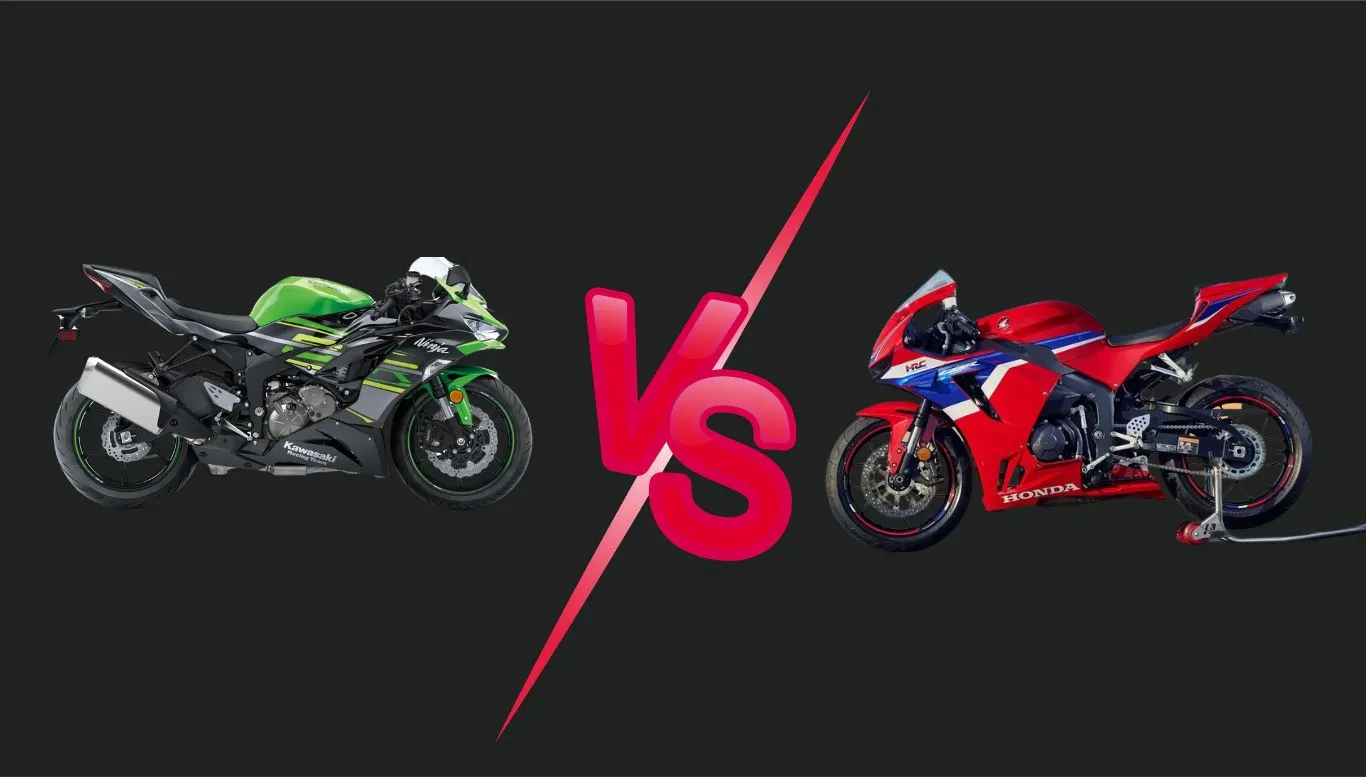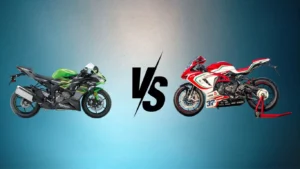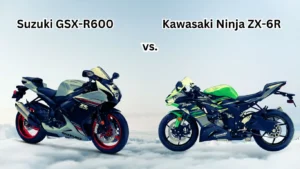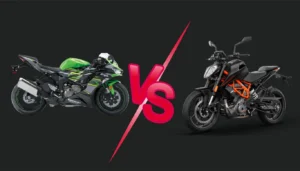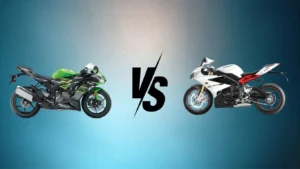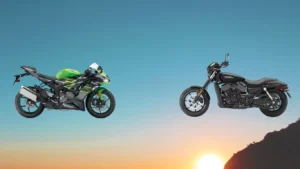If you’re in the market for a supersport motorcycle that offers top-of-the-line speed and power, two names surely come to mind, the Kawasaki Ninja ZX-6R and the Honda CBR600RR. Both these motorcycles have proved their mettle time and again, making them fierce competitors in the racing world.
We understand, as an enthusiast, you may be torn between the two. To help you make an informed decision, we will provide a thorough comparison of the speed, power and overall racing capabilities of the Kawasaki Ninja ZX-6R and the Honda CBR600RR. Buckle up for an exciting ride through this comparison!
Unleashing the Beast: Kawasaki Ninja ZX-6R’s Top Speed
When you ignite the Kawasaki Ninja ZX-6R, you’re not just starting a motorcycle – you’re unleashing a beast. The ZX-6R packs a powerful punch, consistently outperforming many of its competitors in terms of top speed. Let’s dive a little deeper into what makes this speed demon rise to the top.
Ninja ZX-6R: A Symphony of Speed and Engineering
What cements the Ninja ZX-6R’s position at the apex of speed is its masterful blend of top-tier engineering and finely tuned aerodynamics. The bike is meticulously designed to optimize speed and velocity, from its sleek, aerodynamic structure to its expertly crafted engine.
Channeling Power: The Role of the ZX-6R’s Engine in its Top Speed
The ZX-6R’s engine is a testament to Kawasaki’s engineering prowess, serving as the essential powerhouse facilitating its lightning-fast speed. This piece de resistance churns out an intense horsepower, all while maintaining a smooth and stable ride for the inevitable high-speed adventures.
The Cutting Edge: ZX-6R’s Technological Triumphs
The ZX-6R is also a technological marvel. Its advanced, embedded computing systems govern everything from fuel injection to brake force, ensuring the bike can push its boundaries while keeping its rider safe. These technological refinements work synergistically with the bike’s physical elements to facilitate this steed’s incredible top speed.
Power at its Peak: Honda CBR600RR’s Power Output
Unfolding the narrative of power, let’s shift our focus to Honda CBR600RR. Known for its adroit performance, CBR600RR boasts an exceptional power output. This horsepower hero sets pulse racing, embodying Honda’s legacy of engineering excellence. But what drives this peak performance?
Engine – The Heart Of Honda CBR600RR
At the heart of Honda CBR600RR, lies its vigorous engine. The 599cc liquid-cooled inline-four engine is a masterpiece of power. Optimized for balanced performance, this heart-thumping powerhouse contributes significantly towards the bike’s peak power output. The engine delivers a smooth response across a wide powerband, ensuring an exhilarating ride every time.
Transmission – The Power Transmitter
No discussion about power output would be complete without mentioning the bike’s impeccable transmission. The Honda CBR600RR is outfitted with a close-ratio six-speed transmission that seamlessly translates engine power into road-scorching speed. This precision-engineered transmission delivers crisp, quick shifts, ensuring the bike’s horsepower is efficiently utilized.
Aerodynamics – Less Drag, More Power
Aerodynamics play a crucial part in maximizing a motorcycle’s power output. Honda CBR600RR excels in this aspect, boasting a refined aerodynamic design. This not only reduces air drag, but also ensures better stability and control at high speeds. Less resistance means more power to the wheels, making Honda CBR600RR a formidable force on the racetrack.
EFI System – Power Management Master
The Electronic Fuel Injection (EFI) system of Honda CBR600RR is no less than a power management master. It provides the engine with an optimal mix of air and fuel based on the riding conditions. This ensures efficient combustion, resulting in superior power output and improved fuel efficiency. EFI system thus adds a decisive edge to the racing capabilities of Honda CBR600RR.
Clashing Titans: Comparing the Racing Capabilities of Kawasaki Ninja ZX-6R and Honda CBR600RR
Now, let’s delve into the heart of our discussion: the side-by-side comparison of the Kawasaki Ninja ZX-6R and the Honda CBR600RR. Both bikes, renowned for their superb racing capabilities, bring to the table a combination of speed, power, and innovative technology. But how exactly do they stack up against each other? What separates these two racing titans in the brutal, high-speed world of superbikes? Keep reading to find out.
Agility and Handling: A Question of Control
How each bike maneuvers at high speeds is a factor often overlooked, yet it significantly impacts racing performance. The Ninja ZX-6R, known for its agility, uses the Showa BPF (Big Piston Front-fork), promoting smoother handling and better grip on the racing circuit. On the other hand, the CBR600RR boasts a C-ABS system, ensuring optimal balance between the front and rear brakes, contributing to consistent and safer cornering.
Tech Mastery: Examining Onboard Systems and Features
A motorcycle’s technological features are a game-changer in racing, and both the Ninja ZX-6R and CBR600RR don’t fall short in that arena. The ZX-6R’s KTRC (Kawasaki TRaction Control) is a masterpiece in providing increased ride safety and stability. In contrast, the CBR600RR has an advanced HESD (Honda Electronic Steering Damper) system, which offers less resistance at lower speeds and more at higher speeds for improved control.
Suspension Setup: The Difference in Comfort and Stability
The suspension setup of any bike fundamentally influences its control, comfort, and stability. The ZX-6R features a fully adjustable Uni-Trak rear suspension, offering precise control and excellent high-speed stability. Alternatively, the CBR600RR uses a Unit Pro-Link rear suspension; it isolates the effect of rear-end forces on the shock, which ensures a smoother ride, especially at higher speeds.
The Powerhouse Under the Hood: Examining the Engines of Both Superbikes
When it comes to superbikes, what lies underneath the hood plays a crucial role in determining their performance. After all, the engine is the heart of the bike — it’s responsible for generating the power needed to reach those thrilling top speeds! Today, let’s delve into the engine specifics of the Kawasaki Ninja ZX-6R and the Honda CBR600RR to understand how these powerful machines measure up against each other.
The Kawasaki Ninja ZX-6R: The Power of Four
Underneath the hood of the Kawasaki Ninja ZX-6R lies a formidable, liquid-cooled four-cylinder engine. With a capacity of 636cc, this engine brings a deadly combination of power and precision to the table. Venturing into technical specifics, the ZX-6R’s engine showcases a compression ratio of 12.9:1, promising consistency and reliability during high-speed adventures. It’s this engine that allows your Ninja to reach exceptional top speeds while maintaining smooth performance.
The Honda CBR600RR: Six Hundred Cubic Centimeters of Excellence
When it comes to the Honda CBR600RR, the power source is a highly competent liquid-cooled, DOHC, 16-valve, inline-four engine. Notably, the 600cc powerhouse revs up 118 HP at 13,500 RPM, making it a truly high-performance machine. This engine empowers the rider with lightning-fast acceleration, along with an admirable top speed, melding together precision and power.
Power Comparisons: A Study of Specs
By comparing the engines of these two bikes, it’s clear that the Ninja ZX-6R provides slightly more displacement, but do the extra 36cc make a noticeable difference? Certainly, the Ninja benefits from increased torque and flexibility, making it an ideal bike for both track and street riding. The engine of the CBR600RR, meanwhile, stands out for its increased horsepower and high-rev power surge which gives the rider an exhilarating racing experience.
Weight and Balance: A Key Factor in Racing
When it comes to racing, there’s a lot more going on than simply speed and power. The weight and balance of a motorcycle also greatly determine its performance and overall maneuverability. Skilled racers understand that the key to victory often lies in efficiently distributing weight and ensuring optimal balance for tighter control and quicker response. In this section, let’s dissect how these mechanical marvels, the Kawasaki Ninja ZX-6R and the Honda CBR600RR, incorporate the fundamentals of weight and balance.
Lean Machine: Weight Distribution
The weight distribution of a bike is intrinsic to its handling. Kawasaki Ninja ZX-6R and Honda CBR600RR excel in this field with their tight, compact design, which helps to distribute the weight evenly across their chassis. Each has a uniquely crafted frame design that assists in the bike’s agile turns and swift accelerations.
Poise and Control: Rider Balance
Beyond a motorcycle’s weight, the rider’s balance tremendously influences the experience. Both Ninja ZX-6R and the CBR600RR designs cater to anatomical ergonomics, offering riders positions that are comfortable and facilitate better control. By placing the rider’s weight closer to the center, they enhance the bike’s balance, enriching the riding experience.
Corner Kings: Ensuring Stability
Kawasaki Ninja ZX-6R and Honda CBR600RR are both designed for corner grip and stability. Through the use of advanced suspension systems and refined weight-to-power ratios, these bikes are able to cling to the road, even at high speeds. They deliver an effortless and controlled ride when it comes to changing directions, thereby boosting their racing prowess.
A Matter of Poundage: Comparative Weight
The weight of the Kawasaki Ninja ZX-6R and Honda CBR600RR is a crucial aspect to consider. Due to the nature of racing, lighter bikes tend to have an advantage as they can accelerate more swiftly. Moreover, a lighter bike also means lesser load on the engine, which can lead to longer engine life. A comparison between the two can reveal significant insights about their respective performances.
Fuel Efficiency: Which Bike Goes the Extra Mile?
When you’re testing the limits on the racetrack, fuel efficiency may not top your list of priorities. However, in the real world, the ability to get that extra mile does matter. So which of these powerful motorbikes, the Kawasaki Ninja ZX-6R or the Honda CBR600RR, provides the best fuel economy? It’s time to find out.
Fuel Economy Explained: The Art of Stretching the Tank
Fuel economy isn’t simply a measure of how far a bike can travel on a full tank; it’s also about how intelligently it utilizes each drop. Both these superbikes, like most modern motorcycles, employ electronic fuel injection (EFI) systems, which balance power output with fuel consumption, optimizing the function of the engine.
Counting Miles: The Capacity of the Fuel Tanks
When looking at pure numbers, the Kawasaki Ninja ZX-6R features a 17-litre fuel tank, while the Honda CBR600RR comes with a slightly larger 18.1-litre tank. Although a simple comparison, this does provide an initial idea about which bike can potentially travel further without needing a pitstop.
The Practical Lens: Real-World Mileage
Specs aside, the more essential metric is real-world fuel efficiency. In general, the Ninja ZX-6R achieves around 44 to 48 miles per gallon (mpg), while the Honda CBR600RR’s average fuel efficiency is slightly lower, at 40 to 44 mpg. Several factors can influence these numbers, including riding style, road conditions, and even the rider’s weight.
Importance of Fuel Efficiency: Beyond Racing
Fuel efficiency isn’t only about distance. A fuel-efficient engine is often a well-tuned engine, meaning it’s more likely to provide reliable, smooth performance. A highly fuel-efficient bike signals smart engineering, and while it may not define your choice between these two powerhouses, it certainly deserves consideration.
Fuel Tanks and Riding Range: Which Gives You More Miles?
Your tank’s endowment and bike’s overall fuel consumption can significantly influence your overall biking experience. More than just determining how often you’ll be stopping by the gas station, it also plays a crucial role when it comes to long rides and expeditions. How do the Kawasaki Ninja ZX-6R and Honda CBR600RR compare in this regard? Let’s delve into the details.
Fuel Tank Size: A Closer Look
The Kawasaki Ninja ZX-6R comes equipped with a relatively hefty fuel tank, allowing for fewer and far between stops for gas refuels. This means more time on the road and less interruption to your ride. On the other side of the spectrum, the Honda CBR600RR has a slightly smaller fuel tank. While indeed more compact, it may necessitate more frequent refueling stops, especially when venturing on longer routes.
Fuel Consumption Rate: The Numbers Game
Though the Ninja ZX-6R has a larger tank, its more powerful engine can consume fuel at a higher rate, hence potentially balancing out the benefit of its larger tank volume. Meanwhile, Honda’s CBR600RR, despite its smaller tank, has a more efficient engine which consumes fuel more frugally. This fuel efficiency may, in turn, extend your mileage, allowing you to traverse longer distances before needing to refill.
Factors Influencing Fuel Efficiency
Fuel consumption can also be affected by factors apart from your bike’s engine and fuel tank size. Your riding style, the terrain you’re traversing, and the bike’s weight can all play into the fuel efficiency equation. Aggressive riding and steep terrain could increase fuel consumption. Moreover, a heavier bike like the ZX-6R may require more fuel to maintain speeds compared to the leaner CBR600RR.
Effect on Ride Comfort and Convenience
While you may need to stop for fuel more frequently with one bike compared to the other, it’s essential to consider how this could affect your overall biking experience. Could more frequent stops for the Honda add unnecessary interruptions to your ride, or could they serve as welcome breaks during long adventures? Meanwhile, does the Ninja ZX-6R’s less frequent refueling requirement, despite its higher fuel consumption rate, offer a more streamlined biking experience? It all comes down to your personal preferences and needs.
Ninja ZX-6R vs CBR600RR: The Verdict
After a thorough analysis and comparison of both superbikes- the Kawasaki Ninja ZX-6R and the Honda CBR600RR, we’re now ready to reveal our verdict. Taking into consideration factors such as speed, power output, agility, onboard features, and fuel efficiency, it’s time to address the burning question: Which motorbike takes the crown in this head-to-head battle? Let’s delve into the details.
Performance and Speed Capabilities
While both bikes are positioned as high-performance vehicles, they deliver in unique ways. Pay heed to factors like acceleration, top speed, braking efficiency, and responsiveness- aspects that can significantly impact your biking experience. Analysis of these factors might present a clear winner for you, depending on your needs.
Agility and Ride Comfort
Smooth handling and maneuverability are integral to the ride experience. Brake performance, suspension settings, and even the quality of the seat can significantly affect rider comfort. Review these aspects to understand how each bike fares in providing a controlled, comfortable ride.
Technological Innovations and Capabilities
Technology plays a significant role in influencing a bike’s performance. Consider the electronic features, like the traction control system, engine control unit, rider modes, as they enhance safety, and improve the overall riding experience. Factoring in the tech capabilities can help you discern which bike is technologically superior.
Fuel Efficiency and Economy
While speed and power tend to hog the limelight, fuel efficiency is an important aspect as well. It’s the facet that dictates how often you’ll be making pit stops to refuel during your long rides. An assessment of the fuel economy can help determine which superbike will be kinder to your pocket over time.
Conclusion
Choosing between the Kawasaki Ninja ZX-6R and the Honda CBR600RR requires a broader understanding of their standout features, each presenting unique strengths in speed, power, and overall racing capabilities. Your choice ultimately depends on what you value in a bike, whether it’s the superior power of the ZX-6R’s engine, the CBR600RR’s remarkable handling, or their individual fuel efficiency merits.
Acknowledging these motorcycles’ racing prowess, it’s essential to remember that they also offer valuable everyday features. From overall performance to handling, technological innovations, and fuel economy, these superbikes deliver not just on the track, but on everyday roads too, making either a worthwhile choice.
